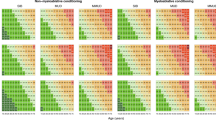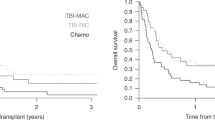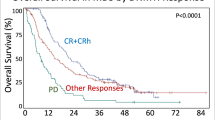Abstract
Non-relapse mortality after Allo-SCT has significantly decreased over the last years. Nevertheless, relapse remains a major cause for post SCT mortality in patients with AML and high-risk myelodysplastic syndrome (MDS). In this retrospective single-center analysis, we have analyzed the treatment outcomes of 108 patients with AML or MDS, who relapsed after Allo-SCT. Seventy of these patients (65%) were treated with salvage therapies containing chemotherapy alone, allogeneic cell-based treatment or the combination of both. Thirty-eight patients (35%) received palliative treatment. Median OS after diagnosis of relapse was 130 days. Compared with patients who received chemotherapy alone, response to salvage therapy was significantly improved in patients treated with a combination of chemo- and allogeneic cell-based therapy (CR rate 57% vs 13%, P=0.002). Among risk factors concerning pretreatment characteristics, disease status before first Allo-SCT, and details of transplantation, only the time interval from Allo-SCT to relapse was an independent predictor of response to salvage therapy and OS. These data confirmed that time to relapse after transplantation is an important prognostic factor. Up to now, only patients eligible for treatment regimens containing allogeneic cell-based interventions achieved relevant response rates.
This is a preview of subscription content, access via your institution
Access options
Subscribe to this journal
Receive 12 print issues and online access
$259.00 per year
only $21.58 per issue
Buy this article
- Purchase on Springer Link
- Instant access to full article PDF
Prices may be subject to local taxes which are calculated during checkout



Similar content being viewed by others
References
Thomas ED, Buckner CD, Banaji M, Clift RA, Fefer A, Flournoy N et al. One hundred patients with acute leukemia treated by chemotherapy, total body irradiation, and allogeneic marrow transplantation. Blood 1977; 49: 511–533.
Liu H, Stock W, Bishop MR . Expanded indications for allogeneic stem cell transplantation in patients with myeloid malignancies. Curr Opin Hematol 2013; 20: 115–122.
Storb RF, Champlin R, Riddell SR, Murata M, Bryant S, Warren EH . Non-myeloablative transplants for malignant disease. Hematol Am Soci Hematol Educ Prog 2001, 375–391.
Bornhauser M, Kienast J, Trenschel R, Burchert A, Hegenbart U, Stadler M et al. Reduced-intensity conditioning versus standard conditioning before allogeneic haemopoietic cell transplantation in patients with acute myeloid leukaemia in first complete remission: a prospective, open-label randomised phase 3 trial. Lancet Oncol 2012; 13: 1035–1044.
Bosi A, Laszlo D, Labopin M, Reffeirs J, Michallet M, Gluckman E et al. Second allogeneic bone marrow transplantation in acute leukemia: results of a survey by the European Cooperative Group for Blood and Marrow Transplantation. J Clin Oncol 2001; 19: 3675–3684.
Frassoni F, Barrett AJ, Granena A, Ernst P, Garthon G, Kolb HJ et al. Relapse after allogeneic bone marrow transplantation for acute leukaemia: a survey by the E.B.M.T. of 117 cases. Br J Haematol 1988; 70: 317–320.
Damaj G, Mohty M, Robin M, Michallet M, Chevallier P, Beguin Y et al. Upfront allogeneic stem cell transplantation after reduced-intensity/nonmyeloablative conditioning for patients with myelodysplastic syndrome: a study by the Societe Francaise de Greffe de Moelle et de Therapie Cellulaire. Biol Blood Marrow Transplant 2014; 20: 1349–1355.
Diez Campelo M, Sanchez-Barba M, de Soria VG, Martino R, Sanz G, Insunza A et al. Results of allogeneic stem cell transplantation in the Spanish MDS registry: Prognostic factors for low risk patients. Leukemia Res 2014; 38: 1199–1206.
Ruutu T, Volin L, Beelen DW, Trenschel R, Finke J, Schnitzler M et al. Reduced-toxicity conditioning with treosulfan and fludarabine in allogeneic hematopoietic stem cell transplantation for myelodysplastic syndromes: final results of an international prospective phase II trial. Haematologica 2011; 96: 1344–1350.
Barrett AJ, Battiwalla M . Relapse after allogeneic stem cell transplantation. Expert Rev Hematol 2010; 3: 429–441.
Tessoulin B, Delaunay J, Chevallier P, Loirat M, Ayari S, Peterlin P et al. Azacitidine salvage therapy for relapse of myeloid malignancies following allogeneic hematopoietic SCT. Bone Marrow Transplant 2014; 49: 567–571.
Ganguly S, Amin M, Divine C, Aljitawi OS, Abhyankar S, McGuirk JP . Decitabine in patients with relapsed acute myeloid leukemia (AML) after allogeneic stem cell transplantation (allo-SCT). Ann Hematol 2013; 92: 549–550.
Sharma M, Ravandi F, Bayraktar UD, Chiattone A, Bashir Q, Giralt S et al. Treatment of FLT3-ITD-positive acute myeloid leukemia relapsing after allogeneic stem cell transplantation with sorafenib. Biol Blood Marrow Transplant 2011; 17: 1874–1877.
Savani BN, Mielke S, Reddy N, Goodman S, Jagasia M, Rezvani K . Management of relapse after allo-SCT for AML and the role of second transplantation. Bone Marrow Transplant 2009; 44: 769–777.
Christopeit M, Kuss O, Finke J, Bacher U, Beelen DW, Bornhauser M et al. Second allograft for hematologic relapse of acute leukemia after first allogeneic stem-cell transplantation from related and unrelated donors: the role of donor change. J Clin Oncol 2013; 31: 3259–3271.
Arellano ML, Langston A, Winton E, Flowers CR, Waller EK . Treatment of relapsed acute leukemia after allogeneic transplantation: a single center experience. Biol Blood Marrow Transplant 2007; 13: 116–123.
Kobayashi K, Kami M, Murashige N, Kusumi E, Kishi Y, Hamaki T et al. Outcomes of patients with acute leukaemia who relapsed after reduced-intensity stem cell transplantation from HLA-identical or one antigen-mismatched related donors. Br J Haematol 2005; 129: 795–802.
Mielcarek M, Storer BE, Flowers ME, Storb R, Sandmaier BM, Martin PJ . Outcomes among patients with recurrent high-risk hematologic malignancies after allogeneic hematopoietic cell transplantation. Biol Blood Marrow Transplant 2007; 13: 1160–1168.
Stelljes M, Beelen DW, Braess J, Sauerland MC, Heinecke A, Berning B et al. Allogeneic transplantation as post-remission therapy for cytogenetically high-risk acute myeloid leukemia: landmark analysis from a single prospective multicenter trial. Haematologica 2011; 96: 972–979.
Schmid C, Schleuning M, Ledderose G, Tischer J, Kolb HJ . Sequential regimen of chemotherapy, reduced-intensity conditioning for allogeneic stem-cell transplantation, and prophylactic donor lymphocyte transfusion in high-risk acute myeloid leukemia and myelodysplastic syndrome. J Clin Oncol 2005; 23: 5675–5687.
Ditschkowski M, Groth C, Silling G, Krug U, Trenschel R, Ottinger H et al. Comparison of different pretransplant predictive scores in patients with refractory acute myeloid leukemia after allogeneic stem cell transplantation including highdose melphalan: results of a double-center observational study. Blood 2013; 122: 4525.
Mrozek K, Marcucci G, Nicolet D, Maharry KS, Becker H, Whitman SP et al. Prognostic significance of the European LeukemiaNet standardized system for reporting cytogenetic and molecular alterations in adults with acute myeloid leukemia. J Clin Oncol 2012; 30: 4515–4523.
Dohner H, Estey EH, Amadori S, Appelbaum FR, Buchner T, Burnett AK et al. Diagnosis and management of acute myeloid leukemia in adults: recommendations from an international expert panel, on behalf of the European LeukemiaNet. Blood 2010; 115: 453–474.
Pavletic SZ, Kumar S, Mohty M, de Lima M, Foran JM, Pasquini M et al. NCI first international workshop on the biology, prevention, and treatment of relapse after allogeneic hematopoietic stem cell transplantation: report from the Committee on the Epidemiology and Natural History of Relapse following Allogeneic Cell Transplantation. Biol Blood Marrow Transplant 2010; 16: 871–890.
van den Brink MR, Porter DL, Giralt S, Lu SX, Jenq RR, Hanash A et al. Relapse after allogeneic hematopoietic cell therapy. Biol Blood Marrow Transplant 2010; 16: S138–S145.
Devillier R, Crocchiolo R, Etienne A, Prebet T, Charbonnier A, Furst S et al. Outcome of relapse after allogeneic stem cell transplant in patients with acute myeloid leukemia. Leuk Lymphoma 2013; 54: 1228–1234.
Matsumoto K, Yamamoto W, Ogusa E, Ishigatsubo Y, Kanamori H . Prognostic index for relapsed acute leukemia after allogeneic stem cell transplantation. Leuk Lymphoma 2014; 55: 2808–2812.
Pollyea DA, Artz AS, Stock W, Daugherty C, Godley L, Odenike OM et al. Outcomes of patients with AML and MDS who relapse or progress after reduced intensity allogeneic hematopoietic cell transplantation. Bone Marrow Transplant 2007; 40: 1027–1032.
Meshinchi S, Leisenring WM, Carpenter PA, Woolfrey AE, Sievers EL, Radich JP et al. Survival after second hematopoietic stem cell transplantation for recurrent pediatric acute myeloid leukemia. Biol Blood Marrow Transplant 2003; 9: 706–713.
Giralt SA, Champlin RE . Leukemia relapse after allogeneic bone marrow transplantation: a review. Blood 1994; 84: 3603–3612.
Sorror ML, Storer BE, Maloney DG, Sandmaier BM, Martin PJ, Storb R . Outcomes after allogeneic hematopoietic cell transplantation with nonmyeloablative or myeloablative conditioning regimens for treatment of lymphoma and chronic lymphocytic leukemia. Blood 2008; 111: 446–452.
Armand P, Kim HT, DeAngelo DJ, Ho VT, Cutler CS, Stone RM et al. Impact of cytogenetics on outcome of de novo and therapy-related AML and MDS after allogeneic transplantation. Biol Blood Marrow Transplant 2007; 13: 655–664.
Armand P, Kim HT, Zhang MJ, Perez WS, Dal Cin PS, Klumpp TR et al. Classifying cytogenetics in patients with acute myelogenous leukemia in complete remission undergoing allogeneic transplantation: a Center for International Blood and Marrow Transplant Research study. Biol Blood Marrow Transplant 2012; 18: 280–288.
Hosing C, Saliba RM, Shahjahan M, Estey EH, Couriel D, Giralt S et al. Disease burden may identify patients more likely to benefit from second allogeneic hematopoietic stem cell transplantation to treat relapsed acute myelogenous leukemia. Bone Marrow Transplant 2005; 36: 157–162.
Stahnke K, Boos J, Bender-Gotze C, Ritter J, Zimmermann M, Creutzig U . Duration of first remission predicts remission rates and long-term survival in children with relapsed acute myelogenous leukemia. Leukemia 1998; 12: 1534–1538.
Schlenk RF, Dohner K, Krauter J, Frohling S, Corbacioglu A, Bullinger L et al. Mutations and treatment outcome in cytogenetically normal acute myeloid leukemia. N Engl J Med 2008; 358: 1909–1918.
Liersch R, Muller-Tidow C, Berdel WE, Krug U . Prognostic factors for acute myeloid leukaemia in adults - biological significance and clinical use. Br J Haematol 2014; 165: 17–38.
Dutour A, Marin V, Pizzitola I, Valsesia-Wittmann S, Lee D, Yvon E et al. In vitro and in vivo antitumor effect of anti-CD33 chimeric receptor-expressing EBV-CTL against CD33 acute myeloid leukemia. Adv Hematol 2012; 2012: 683065.
Marin V, Pizzitola I, Agostoni V, Attianese GM, Finney H, Lawson A et al. Cytokine-induced killer cells for cell therapy of acute myeloid leukemia: improvement of their immune activity by expression of CD33-specific chimeric receptors. Haematologica 2010; 95: 2144–2152.
Tettamanti S, Marin V, Pizzitola I, Magnani CF, Giordano Attianese GM, Cribioli E et al. Targeting of acute myeloid leukaemia by cytokine-induced killer cells redirected with a novel CD123-specific chimeric antigen receptor. Br J Haematol 2013; 161: 389–401.
Ritchie DS, Neeson PJ, Khot A, Peinert S, Tai T, Tainton K et al. Persistence and efficacy of second generation CAR T cell against the LeY antigen in acute myeloid leukemia. Mol Ther 2013; 21: 2122–2129.
Maude SL, Frey N, Shaw PA, Aplenc R, Barrett DM, Bunin NJ et al. Chimeric antigen receptor T cells for sustained remissions in leukemia. N Engl J Med 2014; 371: 1507–1517.
Kalos M, Levine BL, Porter DL, Katz S, Grupp SA, Bagg A et al. T cells with chimeric antigen receptors have potent antitumor effects and can establish memory in patients with advanced leukemia. Sci Transl Med 2011; 3: 95ra73.
Schmeel FC, Schmeel LC, Gast SM, Schmidt-Wolf IG . Adoptive immunotherapy strategies with cytokine-induced killer (CIK) cells in the treatment of hematological malignancies. Int J Mol Sci 2014; 15: 14632–14648.
Laport GG, Sheehan K, Baker J, Armstrong R, Wong RM, Lowsky R et al. Adoptive immunotherapy with cytokine-induced killer cells for patients with relapsed hematologic malignancies after allogeneic hematopoietic cell transplantation. Biol Blood Marrow Transplant 2011; 17: 1679–1687.
Verneris MR, Ito M, Baker J, Arshi A, Negrin RS, Shizuru JA . Engineering hematopoietic grafts: purified allogeneic hematopoietic stem cells plus expanded CD8+ NK-T cells in the treatment of lymphoma. Biol Blood Marrow Transplant 2001; 7: 532–542.
de Lima M, Giralt S, Thall PF, de Padua Silva L, Jones RB, Komanduri K et al. Maintenance therapy with low-dose azacitidine after allogeneic hematopoietic stem cell transplantation for recurrent acute myelogenous leukemia or myelodysplastic syndrome: a dose and schedule finding study. Cancer 2010; 116: 5420–5431.
Bastos-Oreiro M, Perez-Corral A, Martinez-Laperche C, Bento L, Pascual C, Kwon M et al. Prognostic impact of minimal residual disease analysis by flow cytometry in patients with acute myeloid leukaemia before and after allogeneic haemopoietic stem cell transplantation. Eur J Haematol 2014; 93: 239–246.
Elmaagacli AH . Molecular methods used for detection of minimal residual disease following hematopoietic stem cell transplantation in myeloid disorders. Methods Mol Biol 2014; 1109: 187–207.
Rosenow F, Berkemeier A, Krug U, Muller-Tidow C, Gerss J, Silling G et al. CD34(+) lineage specific donor cell chimerism for the diagnosis and treatment of impending relapse of AML or myelodysplastic syndrome after allo-SCT. Bone Marrow Transplant 2013; 48: 1070–1076.
Platzbecker U, Wermke M, Radke J, Oelschlaegel U, Seltmann F, Kiani A et al. Azacitidine for treatment of imminent relapse in MDS or AML patients after allogeneic HSCT: results of the RELAZA trial. Leukemia 2012; 26: 381–389.
Yan CH, Liu DH, Liu KY, Xu LP, Liu YR, Chen H et al. Risk stratification-directed donor lymphocyte infusion could reduce relapse of standard-risk acute leukemia patients after allogeneic hematopoietic stem cell transplantation. Blood 2012; 119: 3256–3262.
Acknowledgements
We would like to thank the staff of our department for their excellent work and all patients.
Author information
Authors and Affiliations
Corresponding authors
Ethics declarations
Competing interests
The authors declare no conflict of interest.
Rights and permissions
About this article
Cite this article
Sauer, T., Silling, G., Groth, C. et al. Treatment strategies in patients with AML or high-risk myelodysplastic syndrome relapsed after Allo-SCT. Bone Marrow Transplant 50, 485–492 (2015). https://doi.org/10.1038/bmt.2014.300
Received:
Revised:
Accepted:
Published:
Issue Date:
DOI: https://doi.org/10.1038/bmt.2014.300
This article is cited by
-
Venetoclax-based salvage therapy followed by Venetoclax and DLI maintenance vs. FLAG-Ida for relapsed or refractory acute myeloid leukemia after allogeneic stem cell transplantation
Bone Marrow Transplantation (2021)
-
PD-1 checkpoint blockade in patients with relapsed AML after allogeneic stem cell transplantation
Bone Marrow Transplantation (2017)



